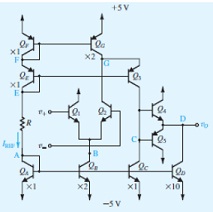Response to the following problem:
For the circuit shown in Fig., which uses a folded cascode involving transistor Q3:all transistors have /VBE / = 0.7 V for the currents involved, VA =200 V, and β = 100. The circuit is relatively conventional except for Q5:which operates in a Class B mode to provide an increased negative output swing for low-resistance loads.
(a) Perform a bias calculation assuming / VBE / = 0.7 V, high β, VA =∞, v+=v-=0 V, and vO is stabilized by feedback to about 0 V. Find R so that the reference current IREF is 100 μA. What are the voltages at all the labeled nodes?
(b) Provide in tabular form the bias currents in all transistors together with gm and ro for the signal transistors (Q1:Q2:Q3:Q4:and Q5:and ro for QC, QD, and QG.
(c) Now, using β=100, find the voltage gai vo/(v+ -v-), and in the process, erify the polarity of the input terminals.
(d) Find the input and output resistances.
(e) Find the input common-mode range for linear operation.
(f) For no load, what is the range of available output voltages, assuming / VCEsat /= 0.3 V? (g) Now consider the situation with a load resistance connected from the output to ground. At the positive and negative limits of the output signal swing, find the smallest load resistance that can be driven if one or the other of Q1:or Q2:is allowed to cut off.
